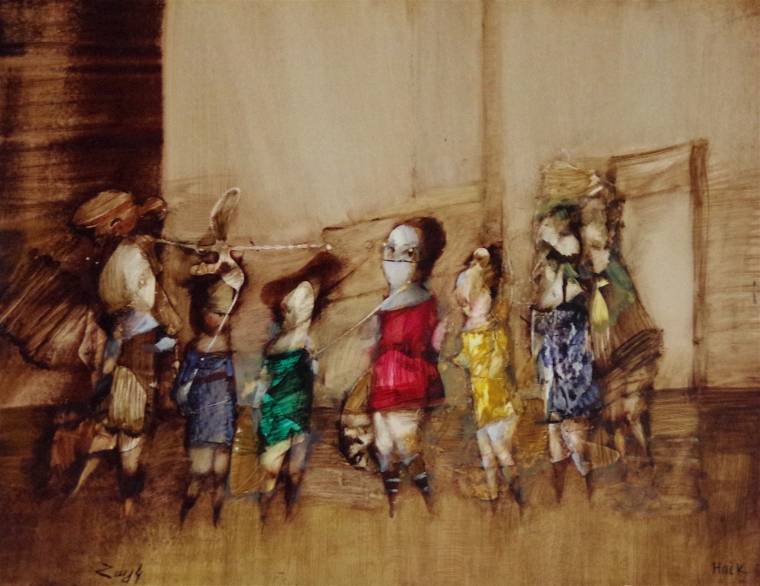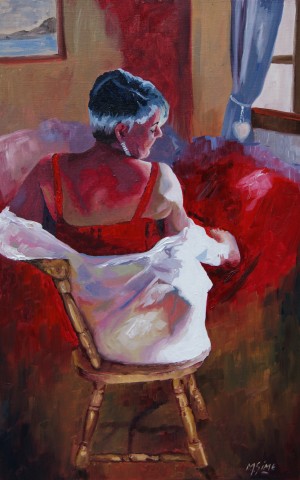How Figurative Oil Painting Transforms Traditional Artistic Expression
How Figurative Oil Painting Transforms Traditional Artistic Expression
Blog Article
The Function of Emotion and Expression in Figurative Oil Painting: An In-Depth Evaluation of Topic and Structure
The interplay of feeling and expression in figurative oil paint acts as an important lens where one can examine the intricate partnership in between topic and composition. Artists harness numerous methods, from color option to brushstroke characteristics, to cultivate psychological vibration within their works. This nuanced orchestration not just forms visitor assumption however also welcomes a much deeper inquiry right into exactly how these components coalesce to reflect the intricacies of human experience. As we explore this abundant terrain, one have to consider exactly how specific instance studies brighten the wider implications of these creative choices.
Understanding Emotion in Art
Feeling in art functions as an effective conduit for expression, permitting artists to communicate complicated sensations through their work. In metaphorical oil paint, this emotional depth is often depicted through the representation of the human number, capturing the nuances of human experience. The option of subject, shade palette, and brushwork all add to the emotional resonance of an item.
Artists regularly bring into play personal experiences, societal concerns, or global motifs to stimulate sensations in the customer. For example, a picture may reflect susceptability, while a vibrant figure in activity can signify flexibility or chaos. These psychological threads connect the audience to the art work, cultivating a discussion that goes beyond the aesthetic tool.
Furthermore, the interplay between light and shadow can enhance emotional strength, guiding the viewer's look and attracting focus to certain components within the make-up. Using texture in oil painting further includes layers of complexity, inviting a responsive feedback that boosts the psychological experience. On the whole, understanding feeling in art is crucial for valuing the nuances that identify metaphorical oil painting, as it transforms plain representation into an extensive exploration of the human problem.
Crucial Element of Structure
In the realm of metaphorical oil painting, the make-up works as the underlying framework that arranges visual components and boosts the psychological narrative. Important elements of make-up include balance, comparison, prime focus, and rhythm, each adding to the general impact of the art work.
Balance describes the distribution of aesthetic weight within the paint, which can be accomplished through in proportion or unbalanced arrangements. A healthy structure provides security, allowing the customer to engage with the piece harmoniously - figurative oil painting. Comparison, on the various other hand, includes juxtaposing various components, such as dark and light or warm and awesome shades, to guide the audience's eye and stimulate psychological feedbacks
The focal factor is important, as it directs attention to the most considerable component of the paint, commonly highlighting the emotional core of the story. By masterfully incorporating these vital aspects, musicians can craft emotionally resonant and compelling metaphorical oil paints that mesmerize and involve their target market.
Topic and Its Effect
Subject issue plays a crucial duty in figurative oil paint, as it not only acts as the structure for the narrative however likewise forms the audience's interpretation and emotional engagement with the art work. The option of subject-- be it a singular figure, a group dynamic, or a thematic representation-- directly affects the psychological environment communicated to the target market.

For example, pictures usually stimulate personal connections, exposing the complexities of human expression and character, while scenes illustrating communal tasks can create a feeling of belonging or nostalgia. Furthermore, the historical and social context of the topic enhances have a peek here the viewer's understanding, triggering deeper reflections on societal standards, worths, and the human condition.
Different subject issues also produce varying levels of interaction; a dramatic dispute shown via figures in stress might elicit sensations of anxiety or compassion, while serene landscapes can invoke peace and consideration. Eventually, the impact of subject issue in figurative oil painting is extensive, as it serves as a channel for psychological vibration, directing the visitor's reaction and analysis, and cultivating a link in between the artwork and the onlooker. This interaction is important for the effective interaction of the artist's intent.
Methods for Stimulating Sensations
The efficiency of figurative oil painting in conveying emotions is dramatically affected by the techniques employed by the artist. One of the most crucial techniques is making use of shade concept, where the strategic selection of shades can evoke certain emotional reactions. Warm colors, such as reds and oranges, frequently evoke feelings of enthusiasm or hostility, while cooler tones like blues and eco-friendlies tend to stimulate calmness or sadness.
Another essential strategy is the manipulation of light and darkness, recognized as chiaroscuro. This approach improves the three-dimensionality of numbers, developing remarkable contrasts that can heighten emotional deepness. The positioning of light can assist customers' emotions, highlighting particular aspects of the make-up.
Brushwork likewise plays a vital duty; loose, expressive strokes can convey energy and spontaneity, whereas smoother methods could suggest peace or precision. The plan of topics within the composition can affect emotional influence. Close proximity can suggest intimacy, while range might show isolation.
Inevitably, the combination of these techniques makes it possible for artists to craft stories that reverberate with the audience, transforming a simple visual experience right into an expressive psychological trip. - figurative oil painting

Situation Studies of Noteworthy Functions
Checking out remarkable works of figurative oil painting reveals just how different methods are utilized to stimulate powerful emotions. One exemplary instance is Edvard Munch's "The Scream," where the altered number and swirling background communicate existential dread. Munch's use shade-- deep blues and vivid oranges-- escalates the emotional impact, showcasing exactly how combination click now choices can form customer experience.
Another considerable job is Pablo Picasso's "Les Demoiselles d'Avignon." Right here, vibrant brushstrokes and fragmented types reflect a tumultuous psychological landscape, challenging conventional representations of the female figure. Picasso's ingenious composition not just catches the visitor's attention yet likewise welcomes reflection on motifs of identity and sexuality.
Furthermore, Frida Kahlo's "The Two Fridas" provides an emotional expedition of duality and self-identity. The different figures, linked by a common heart, exemplify Kahlo's psychological depth and individual story. figurative oil painting. Her thorough interest to detail and symbolic components offer to involve Get More Information viewers on a natural degree
These instance research studies underscore the extensive link between feeling and composition in figurative oil paint, disclosing how musicians harness technique to interact intricate feelings and stories that reverberate across time and culture.

Conclusion
In conclusion, the interaction of feeling and expression in figurative oil paint substantially improves the viewer's experience and analysis of the art work. Through a mindful option of topic and compositional techniques, musicians convey extensive stories that reverberate on both individual and universal degrees. The application of shade brushwork, concept, and chiaroscuro further intensifies psychological deepness, transforming each canvas right into a powerful representation of the complexities of the human experience.
In metaphorical oil painting, this psychological depth is often portrayed via the representation of the human figure, recording the subtleties of human experience.Moreover, the interaction in between light and shadow can magnify psychological intensity, directing the viewer's look and attracting focus to particular elements within the structure. The use of appearance in oil paint even more includes layers of complexity, welcoming a responsive reaction that boosts the emotional experience.The focal factor is vital, as it guides attention to the most significant part of the paint, frequently highlighting the emotional core of the narrative. Inevitably, the impact of subject issue in metaphorical oil painting is profound, as it offers as an avenue for emotional vibration, directing the customer's feedback and analysis, and promoting a connection between the viewer and the art work.
Report this page